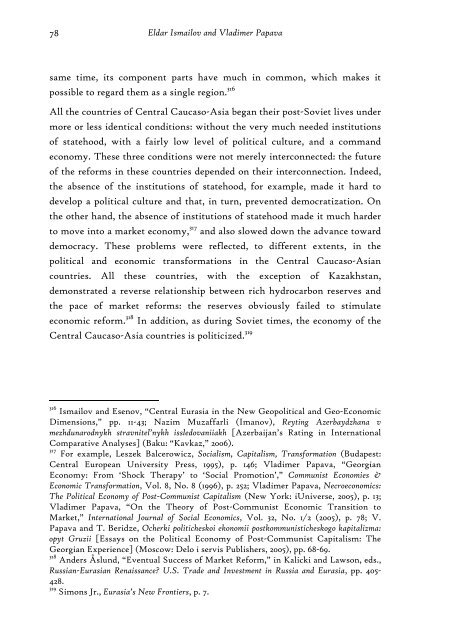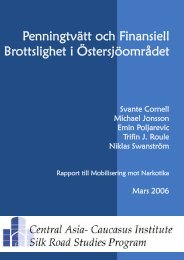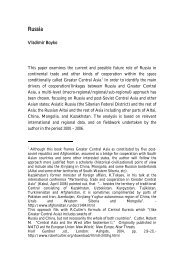Eurasianism and the Concept of Central Caucaso-Asia
Eurasianism and the Concept of Central Caucaso-Asia
Eurasianism and the Concept of Central Caucaso-Asia
Create successful ePaper yourself
Turn your PDF publications into a flip-book with our unique Google optimized e-Paper software.
78<br />
Eldar Ismailov <strong>and</strong> Vladimer Papava<br />
same time, its component parts have much in common, which makes it<br />
possible to regard <strong>the</strong>m as a single region. 316<br />
All <strong>the</strong> countries <strong>of</strong> <strong>Central</strong> <strong>Caucaso</strong>-<strong>Asia</strong> began <strong>the</strong>ir post-Soviet lives under<br />
more or less identical conditions: without <strong>the</strong> very much needed institutions<br />
<strong>of</strong> statehood, with a fairly low level <strong>of</strong> political culture, <strong>and</strong> a comm<strong>and</strong><br />
economy. These three conditions were not merely interconnected: <strong>the</strong> future<br />
<strong>of</strong> <strong>the</strong> reforms in <strong>the</strong>se countries depended on <strong>the</strong>ir interconnection. Indeed,<br />
<strong>the</strong> absence <strong>of</strong> <strong>the</strong> institutions <strong>of</strong> statehood, for example, made it hard to<br />
develop a political culture <strong>and</strong> that, in turn, prevented democratization. On<br />
<strong>the</strong> o<strong>the</strong>r h<strong>and</strong>, <strong>the</strong> absence <strong>of</strong> institutions <strong>of</strong> statehood made it much harder<br />
to move into a market economy, 317 <strong>and</strong> also slowed down <strong>the</strong> advance toward<br />
democracy. These problems were reflected, to different extents, in <strong>the</strong><br />
political <strong>and</strong> economic transformations in <strong>the</strong> <strong>Central</strong> <strong>Caucaso</strong>-<strong>Asia</strong>n<br />
countries. All <strong>the</strong>se countries, with <strong>the</strong> exception <strong>of</strong> Kazakhstan,<br />
demonstrated a reverse relationship between rich hydrocarbon reserves <strong>and</strong><br />
<strong>the</strong> pace <strong>of</strong> market reforms: <strong>the</strong> reserves obviously failed to stimulate<br />
economic reform. 318 In addition, as during Soviet times, <strong>the</strong> economy <strong>of</strong> <strong>the</strong><br />
<strong>Central</strong> <strong>Caucaso</strong>-<strong>Asia</strong> countries is politicized. 319<br />
316 Ismailov <strong>and</strong> Esenov, “<strong>Central</strong> Eurasia in <strong>the</strong> New Geopolitical <strong>and</strong> Geo-Economic<br />
Dimensions,” pp. 11-43; Nazim Muzaffarli (Imanov), Reyting Azerbaydzhana v<br />
mezhdunarodnykh stravnitel’nykh issledovaniiakh [Azerbaijan’s Rating in International<br />
Comparative Analyses] (Baku: “Kavkaz,” 2006).<br />
317 For example, Leszek Balcerowicz, Socialism, Capitalism, Transformation (Budapest:<br />
<strong>Central</strong> European University Press, 1995), p. 146; Vladimer Papava, “Georgian<br />
Economy: From ‘Shock Therapy’ to ‘Social Promotion’,” Communist Economies &<br />
Economic Transformation, Vol. 8, No. 8 (1996), p. 252; Vladimer Papava, Necroeconomics:<br />
The Political Economy <strong>of</strong> Post-Communist Capitalism (New York: iUniverse, 2005), p. 13;<br />
Vladimer Papava, “On <strong>the</strong> Theory <strong>of</strong> Post-Communist Economic Transition to<br />
Market,” International Journal <strong>of</strong> Social Economics, Vol. 32, No. 1/2 (2005), p. 78; V.<br />
Papava <strong>and</strong> T. Beridze, Ocherki politicheskoi ekonomii postkommunisticheskogo kapitalizma:<br />
opyt Gruzii [Essays on <strong>the</strong> Political Economy <strong>of</strong> Post-Communist Capitalism: The<br />
Georgian Experience] (Moscow: Delo i servis Publishers, 2005), pp. 68-69.<br />
318 Anders Åslund, “Eventual Success <strong>of</strong> Market Reform,” in Kalicki <strong>and</strong> Lawson, eds.,<br />
Russian-Eurasian Renaissance? U.S. Trade <strong>and</strong> Investment in Russia <strong>and</strong> Eurasia, pp. 405-<br />
428.<br />
319 Simons Jr., Eurasia’s New Frontiers, p. 7.






